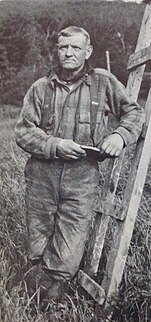Lumberjack

Lumberjackis a mostlyNorth Americanterm for workers in theloggingindustry who perform the initial harvesting and transport of trees. The term usually refers to loggers in the era before 1945 in the United States, when trees were felled using hand tools and dragged by oxen to rivers.
The work was difficult, dangerous, intermittent, low-paying, and involved living in primitive conditions. However, the men built a traditional culture that celebrated strength,masculinity,confrontation with danger, and resistance to modernization.[1]
Term[edit]
The termlumberjackis of Canadian derivation. The first attested use of the term combining its two components comes from an 1831 letter to theCobourg, Ontario,Star and General Advertiserin the following passage: "my misfortunes have been brought upon me chiefly by an incorrigible, though perhaps useful, race of mortals called lumberjacks, whom, however, I would name theCossacksofUpper Canada,who, having been reared among the oaks and pines of the wild forest, have never been subjected to the salutary restraint of laws. "[6]
The termlumberjackis primarily historical, and of colloquial contemporary usage;loggeris commonly used by workers in the 21st century.[7]When lumberjack is used, it usually refers to a logger from an earlier time before the advent ofchainsaws,feller-bunchersand other modern logging equipment. Other terms for the occupation includewoodcutter,shanty boy[8]and the regionalwoodhickof Pennsylvania, United States.[citation needed]In Australia, the occupation is referred to astimber cutter[9]or cool cutters.[10][11]
A logger employed in driving logs down a river was known locally in northern North America as ariver pig,river hog,river rat,orcatty-man.The termlumberjillhas been used for a woman lumberjack; for example, in Britain during World War II.[12]
History[edit]
Lifestyle[edit]
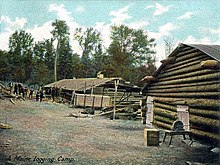
Lumberjacks worked inlumber campsand often lived a migratory life, following timber harvesting jobs as they opened.[13]Being a lumberjack was seasonal work. Lumberjacks were exclusively men. They usually lived inbunkhousesor tents. Common equipment included theaxe[14]andcross-cut saw.Lumberjacks could be found wherever there were vast forests to be harvested and a demand for wood, most likely in Scandinavia, Canada, and parts of the United States. In the U.S., many lumberjacks were of Scandinavian ancestry, continuing the family tradition. American lumberjacks were first centred in north-eastern states such as Maine. They then followed the generalwestward migrationon the continent to theUpper Midwest,and finally thePacific Northwest.Stewart Holbrookdocumented the emergence andwestward migrationof the classic American lumberjack in his first book,Holy Old Mackinaw: A Natural History of the American Lumberjack.He often wrote colourfully about lumberjacks in his subsequent books, romanticizing them as hard-drinking, hard-working men. Logging camps were slowly phased out between World War II and the early 1960s as crews could by then be transported to remote logging sites in motor vehicles.[15]
Division of labour[edit]
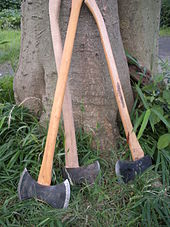
Despite the common perception that all loggers cut trees, the actual felling and bucking of trees were specialized job positions done by fallers and buckers. Faller and bucker were once two separate job titles, but they are now combined.[16]
The natural division of labour in lumber camps led to other specialized jobs on logging crews, such as whistle punk, high climber, and chaser.[17]The whistle punk's job was to sound a whistle (usually at theSteam donkey) as a signal to theyarderoperator controlling the movement of logs. He also had to act as a safety lookout. A good whistle punk had to be alert and think fast as others' safety depended on him. The high climber (also known as a tree topper) established aspartree so logs could be skidded into the landing. Using tree climbing gaffs and rope to ascend a tall tree in the landing area of the logging site, he would chop off limbs as he climbed, chop off the top of the tree, then attach pulleys and rigging to the tree for the yarder. High climbers and whistle punks began to be phased out in the 1960s to early 1970s when portable steel towers began to replace spar trees and radio equipment supplemented whistles for communication. The choker setters attached steel cables (or chokers) to downed logs so they could be dragged into the landing by the yarder, and still do today. The chasers remove the chokers once the logs are at the landing. Choker setters and chasers are often entry-level positions on logging crews, with more experienced loggers seeking to move up to more skill-intensive positions such as yarder operator or supervisory positions such as hook tender.
Machinery[edit]
Before the era of modern diesel or gasoline powered equipment, the existing machinery was steam powered. Animal or steam-poweredskidderscould be used to haul harvested logs to nearby rail roads for shipment tosawmills.Horse drivenlogging wheelswere a means used for moving logs out of the woods. Another way for transporting logs to sawmills was to float them down a body of water or a specially-constructedlog flume.Log rolling,the art of staying on top of a floating log while "rolling" the log by walking, was another skill much in demand among lumberjacks. Spiked boots known as"caulks" or "corks"were used for log rolling and often worn by lumberjacks as their regular footwear.
The term "skid row",which today means a poor city neighbourhood frequented byhomelesspeople, derives from a way harvested logs were once transported. Logs would be "skidded" down hills or along acorduroy road.One such street inSeattlewas named Skid Road. This street later became frequented by people down on their luck, and both the name and its meaning morphed into the modern term.[citation needed]
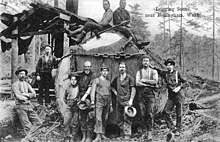
Among theliving historymuseums that preserve and interpret theforest industryare:
- BC Forest Discovery Centre,Duncan
- Camp Five Museum,Laona, Wisconsin
- TheLumberjack Steam Train,a passenger excursion train, operates as part of the museum.
- Central New Brunswick Woodsmen's Museum,Boiestown, New Brunswick
- Coos County Logging Museum,Myrtle Point, Oregon
- Cradle of Forestry in Americahistoric site, nearAsheville, North Carolina
- Forest History Center,Grand Rapids, Minnesota
- Hartwick Pines Logging Museum,nearGrayling, Michigan
- Lumberman's Monument,nearOscoda, Michigan
- Maine Forest & Logging Museum,Bradley, Maine
- Pennsylvania Lumber Museum,nearGaleton, Pennsylvania
- Algonquin Logging Museum[18]inAlgonquin Provincial Park,Ontario
Culture[edit]

Tomczik (2008) has investigated the lifestyle of lumberjacks from 1840 to 1940, using records from mostly Maine and Minnesota logging camps. In a period of industrial development and modernization in urban areas, logging remained a traditional business in which the workers exhibited pride in their craft, masculinity, and closely-guarded individualism. Their camps were a bastion of the traditional workplace, as they intentionally defied modern rationalized management. At the peak in 1906 there were 500,000 lumberjacks. Logging camps were located in isolated areas that provided room and board as well as a workplace. There were usually few women present other than the wives of cooks and foremen. Men earned praise for their skill, competitiveness, and aggression. When not at work, they played rough games, toldtall tales,and built up their reputations byconsuming large amounts of food.By 1940, the business was undergoing major changes, as access roads and automobiles ended residential logging camps, chain saws replaced crosscut saws, and managers installed industrial methods of logging.[19]
Evolution[edit]
Tie hacking[edit]
A specialty form of logging involving the felling of trees for the production ofrailroad tieswas known as tie hacking. These lumberjacks, called tie hacks, used saws to fell trees and cut to length, and abroad-axeto flatten two or all four sides of the log to create railroad ties. Later, portable saw mills were used to cut and shape ties. Tie hacking was an important form of logging in Wyoming and northern Colorado and the remains of tie hacking camps can be found on National Forest land. The remains of flumes can be seen nearDubois, Wyoming,[20]andOld Roach,Colorado. In addition, a decaying splash dam exists near the Old Roach site as well. There, tie hacks attempted to float logs down to the Laramie River for the annual spring tie drives, and the splash dam was used to collect winter snow-melt to increase the water flow for the tie drive.[21]
Modern technology[edit]
Modern technology changed the job of the modern logger considerably. Although the basic task of harvesting trees is still the same, the machinery and tasks are no longer the same. Many of the old job specialties on logging crews are now obsolete.
Chainsaws,harvesters,and feller bunchers are now used to cut or fell trees. The tree is turned into logs by removing the limbs (delimbing) and cutting it into logs of optimal length (bucking). The felled tree or logs are moved from the stump to the landing. Ground vehicles such as askidderorforwardercan pull, carry, or shovel the logs. Cable systems "cars" can pull logs to the landing. Logs can also be flown to the landing by helicopter. Logs are commonly transported to the sawmill using trucks. Harvesting methods may includeclear cuttingorselective cutting.Concerns over the environmental impact have led to controversy about modern logging practices. In certain areas of forest loggers re-plant their crop for future generations.
AWall Street Journalsurvey on the best jobs in the United States ended by listing being a logger as the "worst"3D'sjob,[22]citing "work instability, poor income, and puredanger".According to a Wall St. review studying the 71 most dangerous jobs, the most dangerous job was identified as that of logging workers in 2020.[23]
Safety[edit]
Lumberjacks and loggers have one of the most dangerous jobs in the United States. The constant danger of being around heavy equipment and chainsaws in unsafe areas maximizes the danger. Proper protective equipment consists of eye protection, head protection,ear protection,long sleeves, chaps (if working with a chainsaw), and steel toe boots. When entering this profession, it is emphasized to be on one's toes because individuals are responsible for their own safety to guard against many uncontrollable hazards in the timber. For example, the weather can cause a dangerous situation quicker than one may realize.[citation needed]Additionally, logs and trees often plummet down a mountainside with no regard for what is in the way. In the United States, theOccupational Safety and Health Administration(OSHA) has resources dedicated for logging safety,[24]and theNational Institute for Occupational Safety and Health(NIOSH) has identified logging as a priority area of safety research under theNational Occupational Research Agenda.[25]
Loggersports[edit]

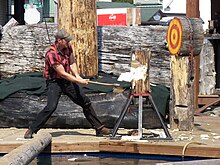
The sport of Loggersports grew out of competitions in lumber camps aimed at determining the best woodcutters. Today, these competitions are used to acknowledge the rich history offorestryand logging and to keep traditions alive.
STIHL Timbersports Series - Worldwide
TheSTIHL Timbersports Serieswas founded in 1985, and brings competitors from across the world to compete in sixwoodsmanorwood choppingcompetitions. The events are broadcast worldwide on a variety of networks, including ESPN, ABC, and Eurosport.[26]
Squamish Days Loggers Sports - Canada
InCanada,Squamish Days Loggers Sports inSquamish, British Columbia,attracts the finest competitors to its weekend festival in August each year. The event has entertainers such asJohnny Cash,who, in 1991, performed at the 5,000-seat Loggers Sports grounds during his Roadshow tour.[27]
The Woodsmen's Days - New York, United States
The Woodsmen's Days events atTupper Lake, New Yorkcommemorate the lumberjack with logging competitions and demonstrations during mid-July. Many colleges have woodsmen teams or forestry clubs who compete regionally, nationally, and internationally. The Association of Southern Forestry Clubs, for example, sponsors an annualForestry Conclavewith 250 contestants and a variety of events.
Lumberjack Tours - United States
There are also lumberjack shows which tour the United States, demonstrating traditional logging practices to the general public. The annualLumberjack World Championshipshave been held inHayward, Wisconsinsince 1960.[28]Over 12,000 visitors come to the event each year in late July to watch men and women compete in 21 different events, including log rolling, chopping, timedhot (power)and bucksaw cutting, andtree climbing.[29]
Lumberjack fashion[edit]

In 2014, the term "lumbersexual"emerged in online culture due to an observation that outdoor gear was used because of its aesthetics, not function.[30]Whereas similar terms such as "the Urban Woodsman" existed since 2012,[31]the term "lumbersexual" became popular in fashion magazines and online outlets during 2015 and 2016.[32]
The term "lumbersexual" is a nearantonymousplay on the earlier "metrosexual",[33]a metropolitan-heterosexual man who values appearances, apparel and aesthetics. Unlike the metrosexual, the lumbersexual is a man who adopted the stylistic traits of outdoor gear, namely abeard,plaid shirt, and work boots, in urban environments.[32][34]
Media reports show lumbersexuals adorned by neck and sleeve tattoos. Whereas commentators discussed whether the lumbersexual is an attempt to "reclaim masculinity",[35][36][37][38]researchers show that the term is a media representation that very few people actually use for self identification.[32]
Popular culture[edit]
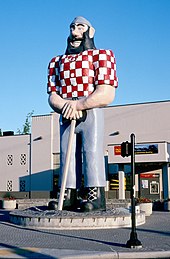

Inpopular culture,the stereotypical lumberjack is a strong, burly, usually bearded man who lives to brave thenatural environment.He is depicted as wearingsuspenders,a long-sleeved plaidflannelshirt, and heavy spikedcaulk boots,and is often characterized as having a voracious appetite, especially forflapjacks.[40][41]He works by cutting down trees with either an axe or with the help of another lumberjack and a crosscut saw, as opposed to the modern chainsaw.[42]
Folklore[edit]
The most famous depiction of a lumberjack in folklore isPaul Bunyan.Several towns claim to have been Paul Bunyan's home and have constructed statues of Bunyan and his blue ox "Babe".[43]
Known for their many exploits, many real life loggers have become renowned for their extraordinary strength, intuition, and knowledge of the woods. Men such asJigger Johnson,theMainewoodsman who supposedly kicked knots off frozen logs barefooted,[44][2]andJoseph Montferrand(better known asBig Joe Mufferaw), theFrench-Canadianknown for his physical prowess and desire to protect the French-speaking logger,[45]have been celebrated asfolk heroesthroughoutNorth America,and have contributed to themythsof the lumberjack.[46]
Music[edit]
Songs[edit]
- Lumberjacks rapidly developed their own distinctive musical culture ofwork songs.Many were based on traditional European folk tunes, with lyrics that reflected the lives, experiences and concerns of lumberjacks, with the themes of cutting, hauling, rolling, and driving, as well as narrative songs that involved romance.[47]
- Big Joe Mufferaw,a song recorded and performed byStompin' Tom Connors,one of Canada's most prolific and well-known country and folk singer-songwriters, about legendary folk heroJoseph Montferrand,a French-Canadian logger. This song appears on the albumStompin' Tom Meets Big Joe Mufferaw(1970), on the live albumLive At The Horseshoe(1971), and on the albumMove Along With Stompin' Tom(1999).
- The Log Driver's Waltz,a 1956 song byWade Hemsworthon his albumFolk Songs of the Canadian North Woods[48]
- Lumberjack,a 1960 song byJohnny Cashon his albumRide This Train
- The Lumberjack,a song byHal Willis
- The Lumberjack,a song featuring a chainsaw solo, by the American rock bandJackyl
- The Lumberjack Song,a song byMonty Python,known for itsrefrain:"I'm a lumberjack and I'm okay / I sleep all night and I work all day...."
See also[edit]
References[edit]
- ^Hayner, Norman S. (April 1945). "Taming the Lumberjack".American Sociological Review.10(2): 217–225.doi:10.2307/2085640.JSTOR2085640.
- ^abHolbrook, Stewart (1938).Holy Old MacKinaw: A Natural History of the American Lumberjack,The Macmillan Company, New York.ISBN1-112-55989-2.
- ^World Film News and Television Progress,vol. 3, no. 6, London Cinema Contact Ltd., October 1938.
- ^Pike, Robert E. (1967).Tall Trees, Tough Men,W. W. Norton & Company,New York.ISBN0393319172.
- ^Holbrook, Stewart (1961).Yankee Loggers: A Recollection of Woodsmen, Cooks, and River Drivers,The International Paper Company, New York.ISBN9781258435714.
- ^"Occupational Image: Lumberjacks".Tyler Rudd Putman. 2012-06-05.Archivedfrom the original on 2014-03-08.Retrieved2013-05-12.
- ^"Logging Industry Workers".Vault.Archivedfrom the original on 2020-11-29.Retrieved2020-09-24.
- ^Benjamin C. Mukkala (1997)."The Shanty Boys"(PDF).Forest History Today.Archived(PDF)from the original on 2016-06-21.Retrieved16 January2017.
- ^"Govt works towards timber cutter compo".ABC News (Australian Broadcasting Corporation). 2005-05-17.Archivedfrom the original on 2023-04-10.Retrieved2010-09-12.
- ^"Our house: histories of Australian homes - Koongalba, The timber getter's residence".Environment.gov.au. 2008-08-07.Archivedfrom the original on 2010-12-06.Retrieved2010-09-12.
- ^[1]ArchivedJuly 19, 2008, at theWayback Machine
- ^"WW2 People's War - The Lumberjills of Scotland".BBC History.2005-08-03.Archivedfrom the original on 2013-09-23.Retrieved2010-09-12.
- ^Rohe, 1986
- ^"Michigan Axe Pattern, Uses and Origin".clutchaxes.com.Archivedfrom the original on 2021-02-01.Retrieved2021-01-13.
- ^Smith (1972)
- ^Sorden and Vallier, 1986
- ^Radford (1987)
- ^"Algonquin Logging Museum".Algonquin Provincial Park.The Friends of Algonquin Park.Archivedfrom the original on 2018-06-18.Retrieved17 June2018.
- ^Adam Tomczik, "'He-men Could Talk to He-men in He-man Language'": Lumberjack Work Culture in Maine and Minnesota, 1840–1940, "HistorianWinter 2008, Vol. 70 Issue 4, pp 697-715
- ^Pinkerton, Joan (1981).Knights of the Broadax; the Story of the Wyoming Tie Hack.Caxton Printers.ISBN0-87004-283-1.
- ^Jones, Keith.History of Jelm, Wyoming.Vol. 1. p. 17.Archivedfrom the original on 2023-04-10.Retrieved2019-08-16.
- ^"Career & Job News, Work, Employment & Salary Trends - Wall Street Journal - WSJ.com".Careerjournal.com.Archivedfrom the original on 2008-01-20.Retrieved2010-09-12.
- ^Clanton, Nancy; Journal-Constitution, The Atlanta."These are the most dangerous jobs in America".The Atlanta Journal-Constitution.Archivedfrom the original on 2020-11-17.Retrieved2020-11-19.
- ^"Logging - Overview | Occupational Safety and Health Administration".www.osha.gov.Archivedfrom the original on 2020-11-23.Retrieved2020-11-19.
- ^"CDC - NIOSH - NORA Agriculture, Forestry and Fishing Sector Council".www.cdc.gov.Center for Disease Control.2019-02-11.Archivedfrom the original on 2020-10-24.Retrieved2020-12-09.
- ^"STIHL TIMBERSPORTS | Lumberjack Competition Series".Stihl USA.Archivedfrom the original on 2016-07-08.Retrieved2016-07-08.
- ^Sylvie Paillard (2010-07-25)."The spectacle on the world stage".Squamishchief.com.Retrieved2015-10-15.[permanent dead link]
- ^Murphy McGinnis Interactive."Hayward, Wisconsin".Lumberjack World Championships. Archived fromthe originalon 2010-10-24.Retrieved2010-09-12.
- ^"Lumberjack World Championships | Hayward, WI".www.lumberjackworldchampionships.com.Archivedfrom the original on 2019-12-21.Retrieved2020-01-15.
- ^Puzak, Tom (2014-10-30)."The Rise of the 'Lumbersexual'".GearJunkie.Archivedfrom the original on 2022-11-29.Retrieved2022-11-29.
- ^"Consider The Urban Woodsman".The Awl.Archivedfrom the original on 2022-12-09.Retrieved2022-11-29.
- ^abcDiaz Ruiz, Carlos A.; Kjellberg, Hans (2020)."Feral segmentation: How cultural intermediaries perform market segmentation in the wild".Marketing Theory.20(4): 429–457.doi:10.1177/1470593120920330.ISSN1470-5931.S2CID219027435.Archivedfrom the original on 2022-11-29.Retrieved2022-11-29.
- ^Simpson, Mark (2002-07-22)."Meet the metrosexual".Salon.Archivedfrom the original on 2022-11-29.Retrieved2022-11-29.
- ^Baxter, Holly (14 November 2014)."Out of the woods, here he comes: the lumbersexual".The Guardian.Archivedfrom the original on 2015-01-28.Retrieved6 February2015.
- ^Nicks, Denver."Confessions of a Lumbersexual".Time.Archivedfrom the original on 2015-02-08.Retrieved6 February2015.
- ^Mychaskiw, Marianne (September 24, 2015)."Leonardo DiCaprio Chops Off His Man Bun".InStyle. Archived fromthe originalon January 25, 2016.RetrievedJanuary 5,2016.
- ^Tang, Dennis (Jun 25, 2015)."Why 'Athleisure' Replaced the Urban Lumberjack".Esquire. Archived fromthe originalon January 12, 2016.RetrievedJanuary 5,2016.
- ^Lumbersexuality and Its DiscontentsArchived2017-03-03 at theWayback Machineby Willa Brown (December 10, 2014),The Atlantic
- ^Lehtinen, Lasse: Nätti Watchdog. Finnish adventurer biography. Espoo: Paasilinna, 2012.ISBN978-952-5856-65-1
- ^The Explorers of Mendham, N.J. (October 1953),"Our lumberjack rolic",Boys' Life,vol. 43, no. 10, pp. 26–27,
Lumberjacks and flapjacks go together.
- ^Haynes, John E. (2002). "Revolt of the" Timber Beasts ": IWW lumber strike in Minnesota". In Aby, Anne J. (ed.).The North Star State, a Minnesota History.Minnesota Historical Society Press.
The brawny lumberjack who tells tales, fells giant trees, wears checkered shirts and loves flapjacks is familiar in American folklore.
- ^Samuel, R.; Thompson, P. R. (1990).The Myths We Live By.London: Taylor & Francis. pp. 132–136.
- ^Dorson, R. M. (1977) [1961].American folklore: with revised bibliographical notes(2nd ed.). University of Chicago Press. p. 216.
- ^Monahan, Robert. "Jigger Johnson",New Hampshire Profiles magazine,Northeast Publications, Concord, New Hampshire, April, 1957.
- ^Colombo, J. R. (1984).Canadian literary landmarks.Dundurn Press. p. 158.
- ^AppalachiaAppalachian Mountain Club, 1964.
- ^Mood, T. A. (2004).American Regional Folklore: A Sourcebook and Research Guide.ABC-CLIO. pp. 220–222.
- ^Levy, Joel (December 8, 2016)."The History of The Log Driver's Waltz".The Toronto Guardian.Archivedfrom the original on 2016-12-11.RetrievedMarch 28,2017.
Further reading[edit]
- Brock, Emily K.Money Trees: The Douglas Fir and American Forestry, 1900-1944(Oregon State University Press, 2015). 272 pp.
- Chaney, Michael P.White Pine on the Saco River: An Oral History of River Driving in Southern Maine(University of Maine Press, 1993)
- Cox, Thomas R.The Lumberman's Frontier: Three Centuries of Land Use, Society, and Change in America's Forests(Oregon State University Press, 2010); 560 pages; examines successive frontier regions prized for lumber rather than farming, beginning with northern New England in the 17th century
- Griffiths, Bus.Now You're Logging,Harbour Publishing, 1978.
- Hayner, Norman S. "Taming the Lumberjack,"American Sociological Review,Vol. 10, No. 2, (April, 1945), pp. 217–225in JSTOR,description of lifestyle
- Holbrook, Stewart H.Holy Old Mackinaw: A Natural History of the American Lumberjack,1938, popular
- Holbrook, Stewart H.The American Lumberjack(Collier Books, 1962), popular account
- Karamanski, Theodore J.Deep Woods Frontier: A History of Logging in Northern Michigan(1989)
- Lee, David.Lumber Kings and Shantymen.Ottawa, Ontario, Canada: 2006.
- Lemonds, James.Deadfall: Generations of Logging in the Pacific Northwest.Missoula: Mountain Press, 2001.
- Mackay, Donald. "The Canadian Logging Frontier,"Journal of Forest History1979 23(1): 4-17
- Radforth, Ian.Bushworkers and Bosses: Logging in Northern Ontario, 1900–1980(University of Toronto Press, 1987).
- Robbins, William G.Lumberjacks and Legislators: Political Economy of the U.S. Lumber Industry, 1890-1941(Texas A. & M. U. Press, 1982). 268 pp.
- Roberge, Earl.Timber Country.Caldwell, Idaho: Caxton Printers, 1973.
- Rohe, Randall E. (1986).The Evolution of the Great Lakes Logging Camp, 1830-1930.Vol. 30. pp. 17–28.
{{cite book}}:|work=ignored (help) - Smith, David C.A History of Lumbering in Maine, 1861–1960(University of Maine Press, 1972)
- Sorden, L. G. and Vallier, Jacque.Lumberjack Lingo: A Dictionary of the Logging Era.(Ashland, Wis.: NorthWord, 1986). 288 pp.
- Tomczik, Adam, "'He-men Could Talk to He-men in He-man Language'": Lumberjack Work Culture in Maine and Minnesota, 1840–1940, "HistorianWinter 2008, Vol. 70 Issue 4, pp 697–715
External links[edit]
- William Reed (Timber getter) c.1930- photo from the Jones-Mashman Collection at Lake Macquarie Library.
- University of Washington Libraries: Digital Collections:
- Clark Kinsey PhotographsOver 1000 images by commercial photographer Clark and his brother Darius Kinsey documenting the logging and milling camps and other forest related activities in Washington State, ca. 1910–1945.
- Industry and Occupations PhotographsAn ongoing and expanding collection devoted to the workers in the Pacific Northwest from the 1880s to the 1940s. Many occupations and industries are represented including the logging and lumber industry.
- Man to Machine: Peninsula LoggingOnline museum exhibit based upon the Clark Kinsey Logging Photographs Collection and the recollections of Harry C. Hall, who worked as a logger on the Olympic Peninsula in the early 20th century. Includes a video on the Hobi family logging history (late 19th century – early 20th century).
- OSHA.govAn overview of logging operations along with safety standards and other important safety links.

